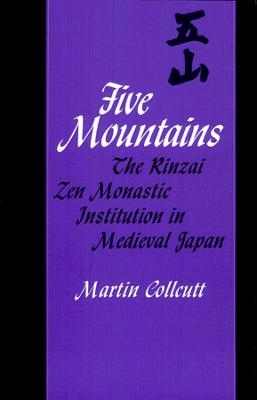
Five Mountains
Harvard University, Asia Center (Verlag)
978-0-674-30498-7 (ISBN)
- Titel z.Zt. nicht lieferbar
- Versandkostenfrei innerhalb Deutschlands
- Auch auf Rechnung
- Verfügbarkeit in der Filiale vor Ort prüfen
- Artikel merken
In Japan today, Zen monastic life is practiced substantially as it was practiced in medieval Japan or Sung dynasty China. More than twenty-one thousand Zen temples are active. This book examines the Zen monastery as a major institution in medieval Japanese society. Focusing on the Five Mountains network of officially sponsored Zen monasteries, it describes the transmission of Rinzai and Soto Zen to Japan, traces the patterns of secular patronage, and discusses in detail the Zen monastic environment, the monastic rule, the community, and the economy.
This is the first detailed study in any Western language of the social and institutional development of Zen Buddhism. Martin Collcutt’s illustrated text should be valuable to those interested in medieval Japanese history as well as students of Zen practice and Zen-related culture.
Martin Collcutt is Professor of East Asian Studies and History at Princeton University.
Part 1 The development of the institution: Japanese Zen pioneers and their patrons - stages of acculturation, motives of Japanese Zen pioneers, Eisai and the Kamakura Shogunate, Enni and Kujo Michiie, Shinchi and the ideal of the recluse, Dogen and his patrons; Chinese emigre monks and Japanese warrior-rulers - Hojo patronage, Hojo Tokiyori and Lan-ch'i Tao-lung, Hojo Tokiyori and Wu-an P'u-ning, Hojo Tokimune's patronage of Zen, Hojo Tokimune and Wu-hsuch Tsu-yuan, Hojo Sadatoki and I-shan I-ning, Hojo Takatoki's patronage of Zen, the Zen contribution to warrior culture, provincial diffusion of Zen, imperial patronage of Zen; the articulation of the Gozan system - Go-Daigo and Muso, reorganization of the Gozan, Go-Daigo's motives, Ashikaga patronage of Zen, Takauji and Tadayoshi, the building of Tenryuji and Ashikaga power, Ankokuji and Rishoto, Gozan, Jissatsu, and Shozan, regional distribution, centralization and control of the Gozan by the Ashikaga, the Tenka Soroku and the Inryoshoku, Zenith and the decline, the emergence of Daitokuji and Myoshinji. Part 2 The structure of the institution: The Zen monastic life and rule - the development of the rule, the problem of the Pai-chang code, the Ch'an-men regulations and the Ch'an-yuan code, introduction of the Ch'an monastic rule to Japan, the Rinsenji code, Bakufu regulation of the Gozan; the monasteries and its sub-temples - transmission of the ground plan, the setting, the layout, gates, the Buddha hall, the Dharma hall, the Abbot's building, the bathhouse, latrines, and washstands, the monk's hall, the reading room, the kitchen-office; the community - population, the abbot, the officers, acolytes, postulants and novices; the Zen monastic economy - Ch'an communities in China, Japan: Zen monastic domains, the Engakuji economy, the Nanzenji economy, the Daitokuji economy, management of the Zen monastic domain.
| Erscheint lt. Verlag | 5.2.1996 |
|---|---|
| Reihe/Serie | Harvard East Asian Monographs |
| Sprache | englisch |
| Maße | 152 x 229 mm |
| Gewicht | 626 g |
| Themenwelt | Geschichte ► Allgemeine Geschichte ► Mittelalter |
| Geisteswissenschaften ► Geschichte ► Regional- / Ländergeschichte | |
| Geisteswissenschaften ► Religion / Theologie ► Buddhismus | |
| ISBN-10 | 0-674-30498-5 / 0674304985 |
| ISBN-13 | 978-0-674-30498-7 / 9780674304987 |
| Zustand | Neuware |
| Haben Sie eine Frage zum Produkt? |
aus dem Bereich


